2024 Update: Please note that Virunga National Park is closed for the foreseeable future and so the gorilla trekking detailed in this article is not currently available to book. Keep an eye on the Virunga National Park website in case this changes but given the extent of fighting in the region, I don’t expect it to be anytime soon.
The first thing I noticed was the normality.
As I inched a tentative toe across the border between Rwanda and the Democratic Republic of the Congo, I half expected to have a bag thrown over my head by a group of militia rebels, disappearing off the face of the earth until my body was unearthed in a mass grave months later.
“Lauren!” A voice called out to me, and a guy waved frantically in my direction when I looked up.
That was easy. I’d arranged a pick-up with my hotel in Goma, where I’d be spending my first night in the DRC, and so far, everything seemed to be going smoothly.
I hopped up into the front seat of his truck and stared out at the chaotic streets of another unfamiliar city.
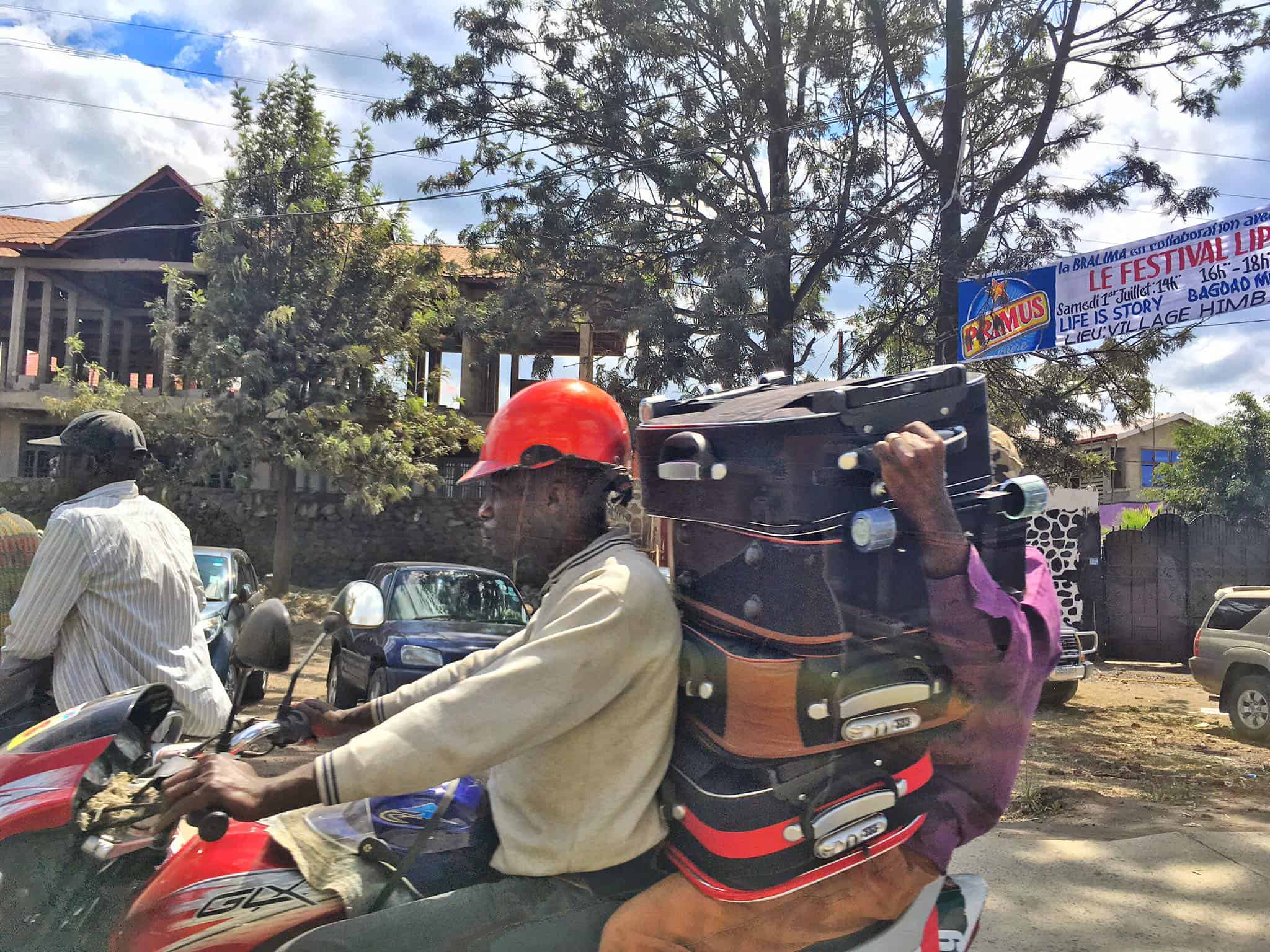
I wasn’t scared.
I thought I would feel scared.
I was in Goma, a city the British government advises against all but essential travel to, and it felt just as safe as anywhere else I’d visited in the world. Music rang out from car stereos, scooters weaved in and out of traffic, women shopped at bustling markets, and men pushed overpacked chukudus down the streets.
Goma felt normal.
The border crossing had been one of the easiest of my ten years of travel: no bribes, no scams, no hassle. Smiling locals had led me from Rwanda to the Congolese immigration desk, insisting that I jump to the front of the queue; welcoming me to the D.R.C. When I wandered off in the wrong direction after receiving my visa, someone jogged after me to show me where to go.
This is one of the most dangerous countries in the world?
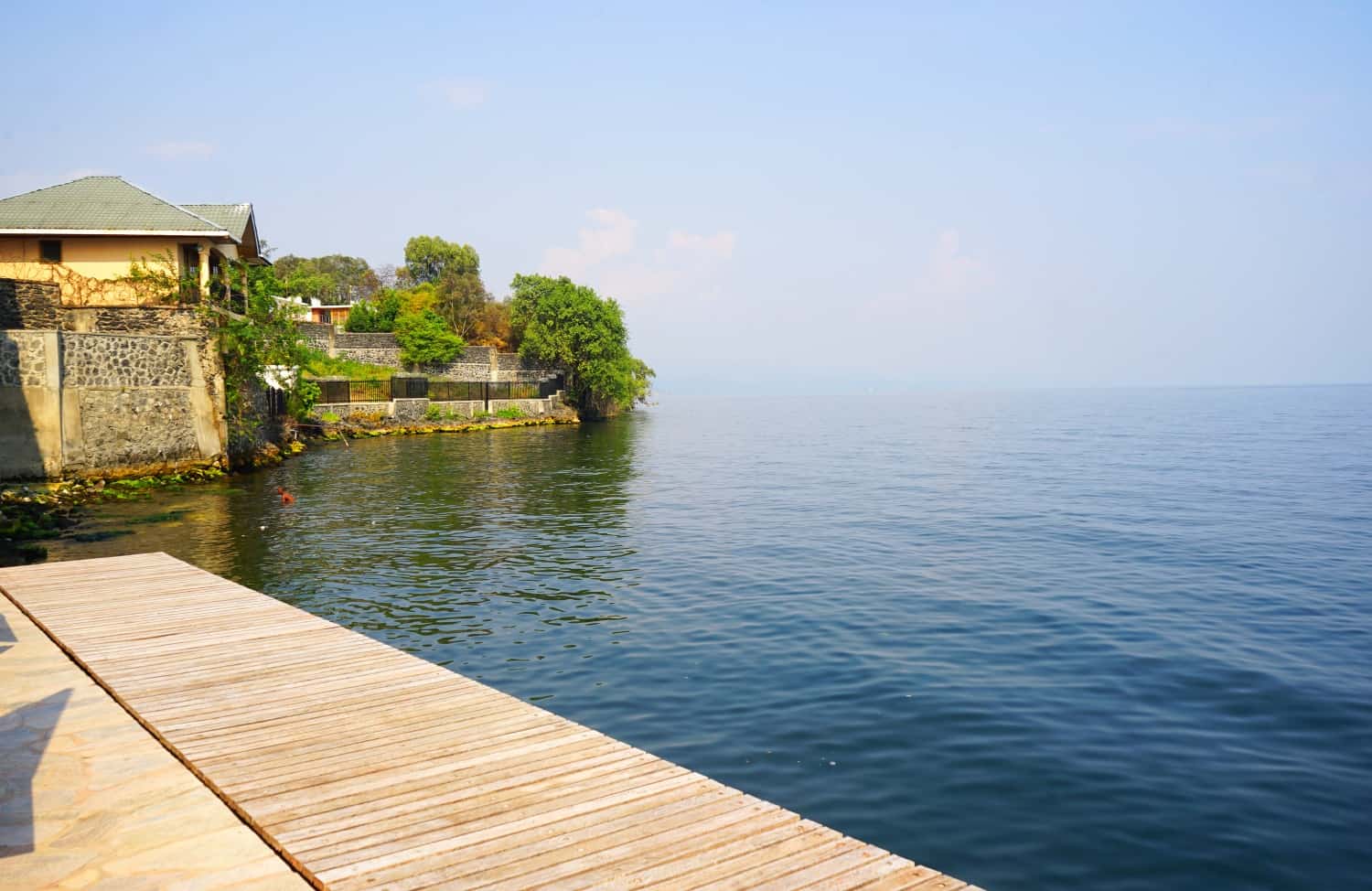
I checked in to Lac Kivu Lodge, on the shores of Lake Kivu. It’s the best-rated hotel in the city and a popular hangout for UN workers and expats who are craving a slice of calm in a chaotic city. It’s a peaceful spot with modern rooms, lovely gardens, and a lively restaurant.
Behind its peace, however, there was reason to be nervous. Fun fact: Lake Kivu is currently sitting on top of 300 cubic kilometres of carbon dioxide and 60 cubic kilometres of methane. For now, they’re trapped beneath the water, but if something were to happen — like, say, an eruption of the active Mount Nyiragongo, the gas could be disturbed, rise to the surface, and kill millions of people.
You couldn’t have guessed such danger laid beneath its surface when looking out across it.
And then there’s the danger of Mount Nyiragongo itself. It erupted in 2002 and 2021, and the effects are still visible in Goma today: black volcanic rocks are scattered across the city and used to create fences, roads, and homes, making it look like a place that had been built on the moon. Back in 2002, the eruption killed just 150 people, thanks to early warnings and the evacuation of 400,000 people, but 120,000 of those people were left homeless afterwards. Nyiragongo has erupted over 30 times in the last hundred years or so, and it will erupt again sometime soon.
And you can’t forget the ever-present risk from rebel groups in the area, either. Goma was captured by a militia group back in 2012, who fired shells and bullets into the city, and remained in control for just over a week.
In short, the city may have felt safe while I was there, but there are plenty of potential dangers to be aware of.
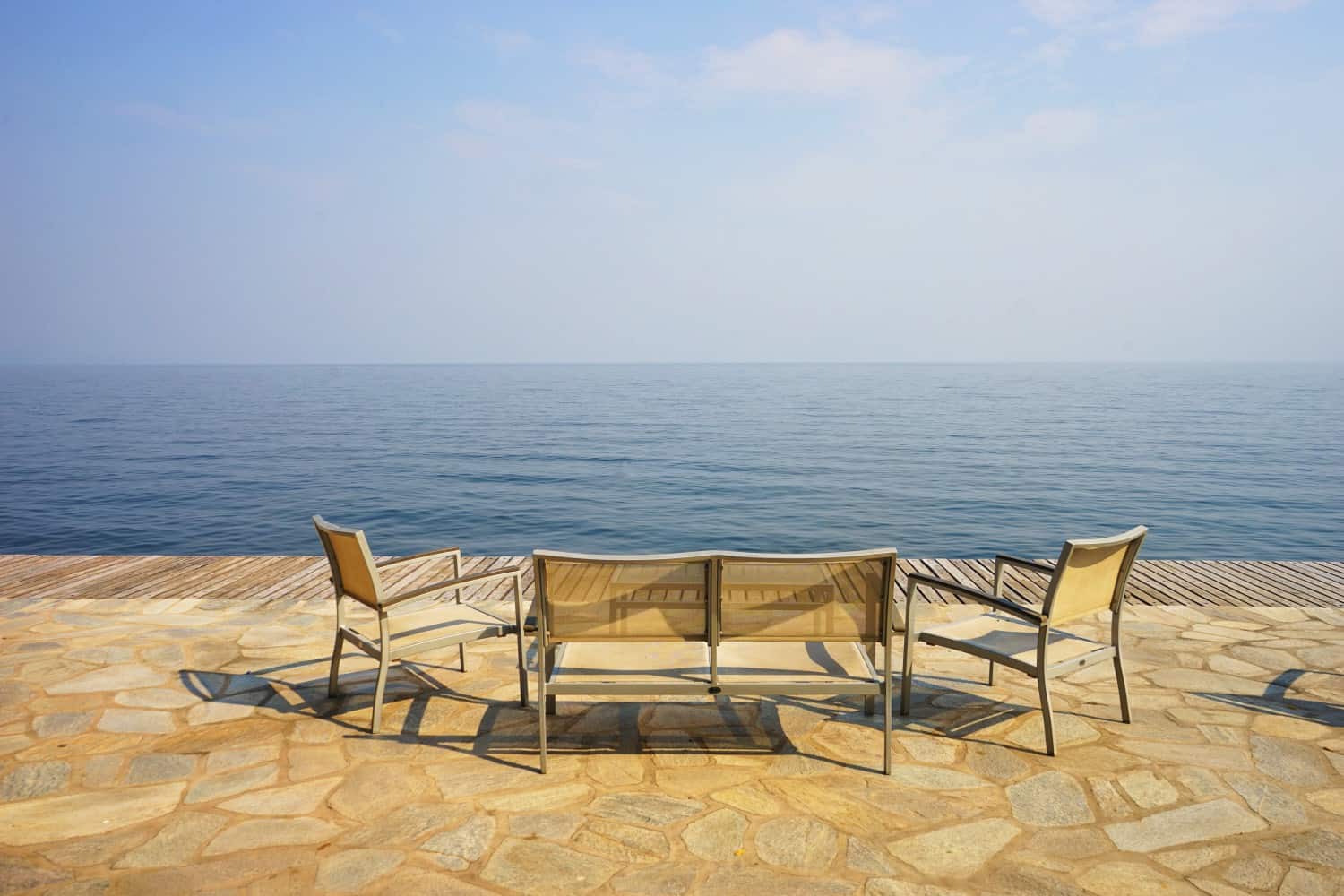
Always up for to trying a new dish, I opted for sambaza for lunch: fried sardines that had been caught in Lake Kivu and a plate of Goma cheese. They were perfect for snacking and I have to confess that Goma chese is the best cheese ever. Formerly a Belgian colony, the DRC has an unexpected-yet-thriving cheese-making scene that was kicked off by Belgian priests back in the 70s. Unfortunately, you can’t find Goma cheese easily outside of the country, which bums me out, as it was seriously good cheese.
My trip to the DRC was off to a smooth start, and I had just one afternoon in Goma to relax. Tomorrow, I’d be heading to Bukima to begin my trek to see wild mountain gorillas. I was itching to get started.
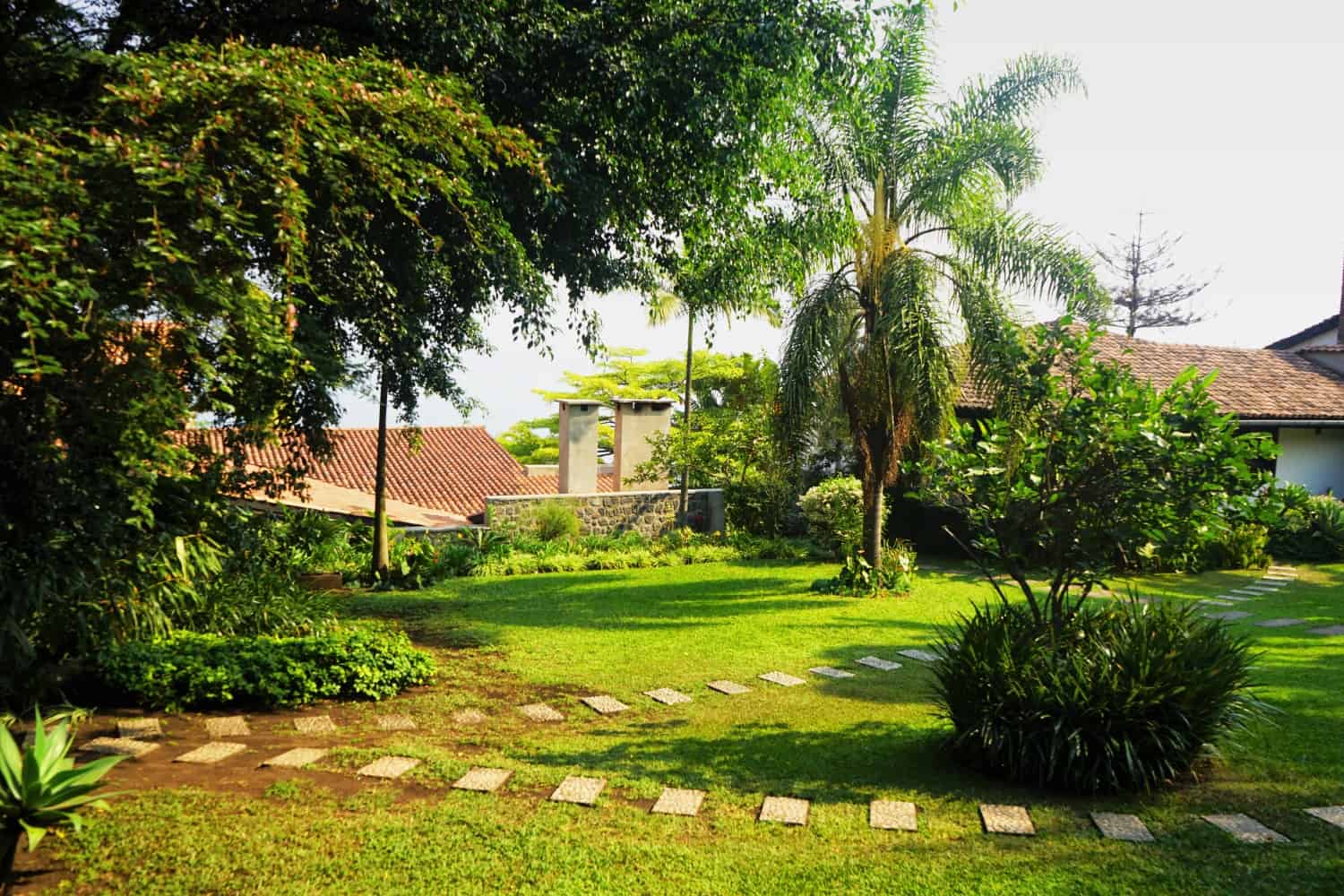
I rose at 6 a.m., grabbed a quick breakfast, and was greeted by someone from Virunga National Park on the streets of Goma.
You wouldn’t expect the Congo to be home to the most efficient national park in the world, but I’m calling it: that’s exactly what Virunga is.
Their website makes independent travel so unbelievably simple that there’s absolutely zero need for you to utilise a tour company in order to visit. On their site, you’ll be able to select a package that includes accommodation, trek permits, and transportation, allowing you to book everything you need in one fell swoop. I booked the Mikeno Mist package, which includes gorilla trekking and an overnight hike to Mount Nyiragongo, along with transport to and from the border and between all of the activities, plus three nights of accommodation.
The booking experience had been seamless, and I was naming this one of the tightest-run operations I’ve encountered on my travels.
I jumped up into the Virunga truck, and we cruised through a much-calmer Goma to pick up my rangers for the day.
Virunga is all about keeping tourists safe, so every truck comes accompanied by two rangers and their enormous AK-47s. When people ask me if I was being a reckless loon by heading to one of the most dangerous countries in the world, I remind them that no tourists have ever been killed while trekking with gorillas in Virunga, which is the oldest national park in Africa. On top of that, Virunga always closes the park if they sense the visitors will be in any kind of danger. Taking all of that into account, I believe you’d likely be more safe in Virunga than in many other national parks around the world.
I was overjoyed when I learned my two rangers for my trip were women! I’d read a fascinating National Geographic piece about the first women rangers at Virunga National Park before I left, so it was badass to now have two of them keeping me safe in the park.
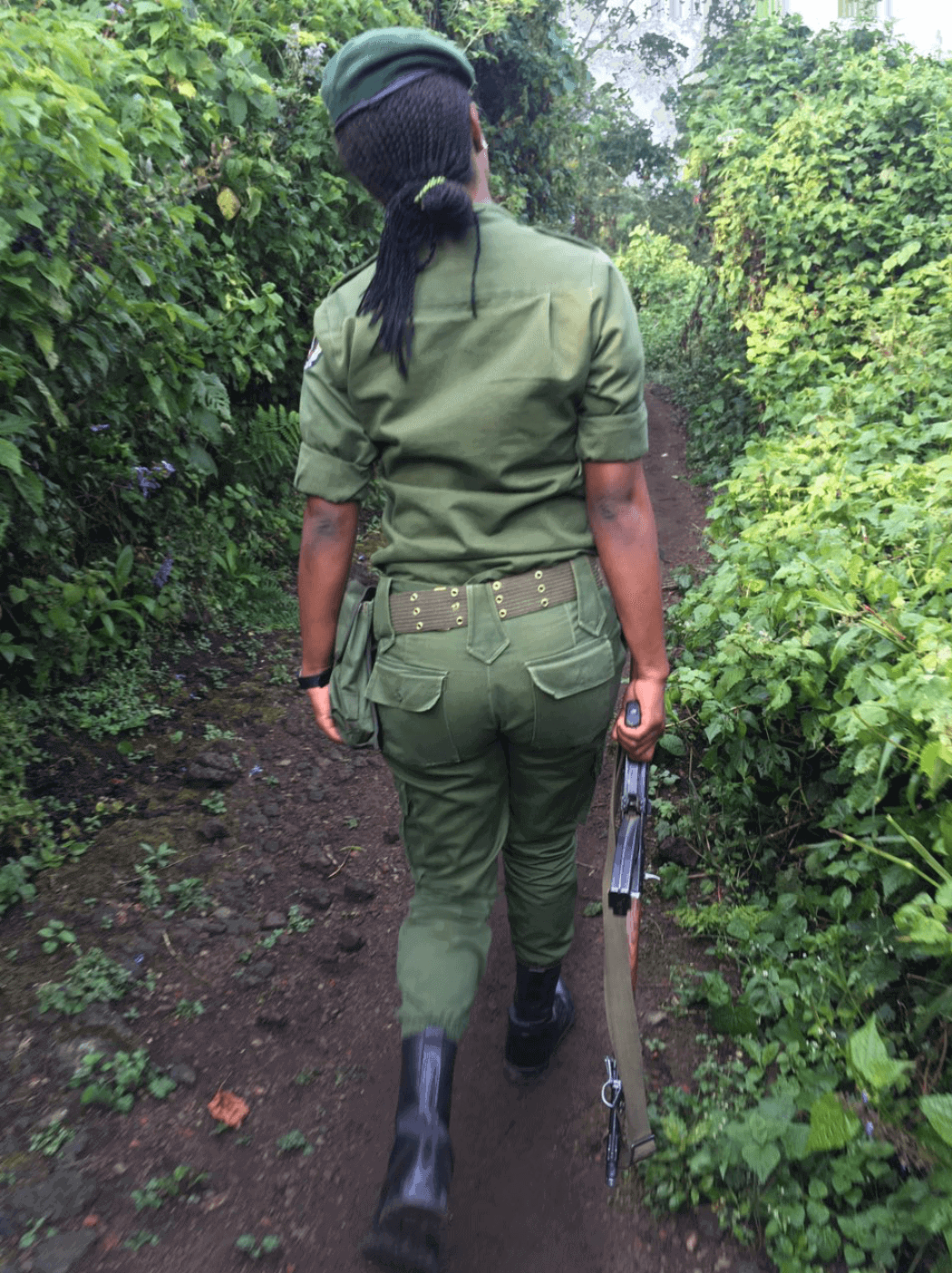
In the DRC, they take gorilla conservation seriously.
On average, a ranger at Virunga National Park is killed each and every month. It’s simply the reality of working the most dangerous wildlife job in the world. Over 200 rangers have now been killed in the line of duty in Virunga, either by poachers or rebels, all while attempting to keep the gorillas safe from harm.
It’s one of the main reasons why I opted to go gorilla trekking in the DRC over Rwanda or Uganda. I wanted to support the incredible work these rangers do, and the risks they take, all in the name of conservation.
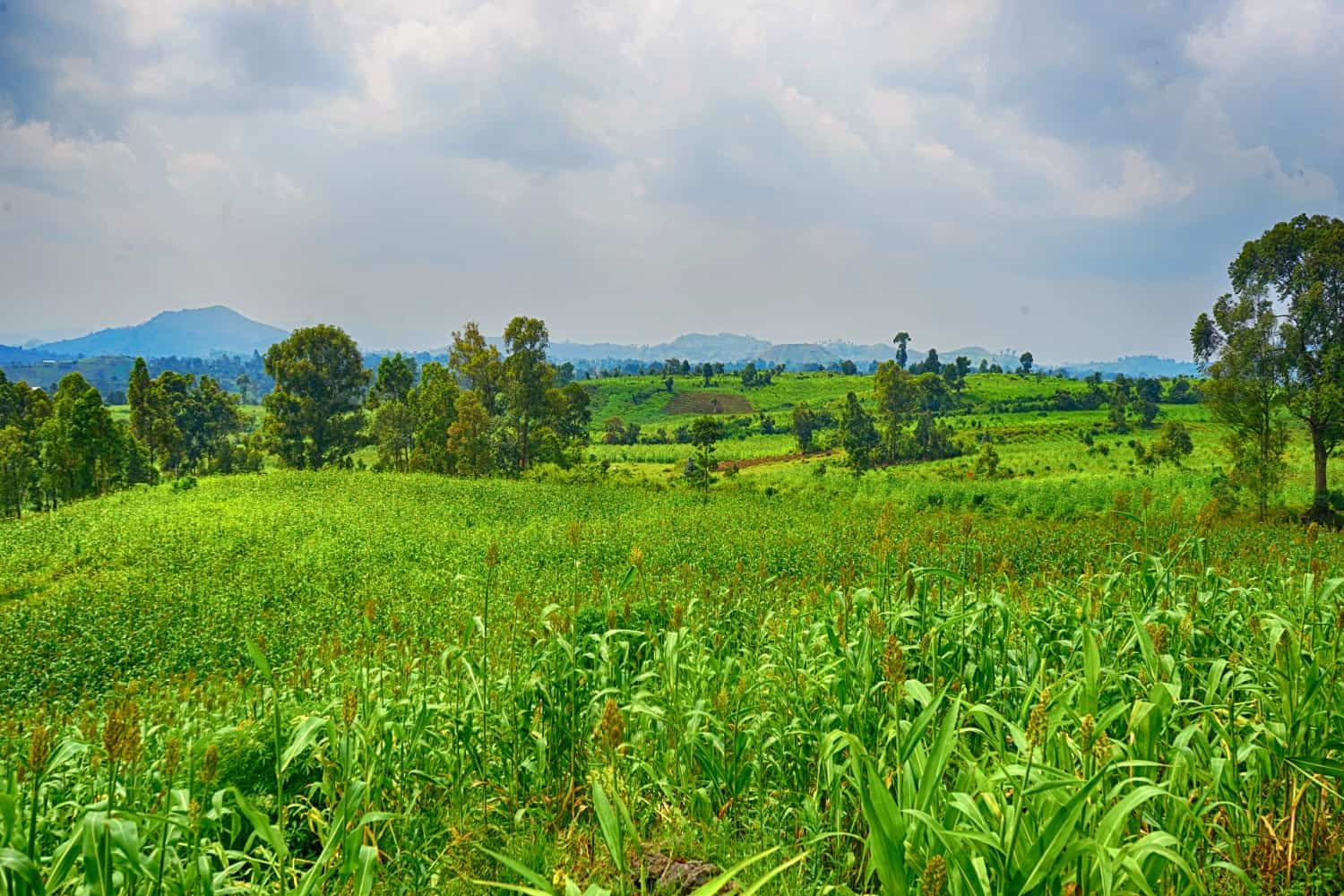
My truck pulled up at the departure point, alongside half a dozen other vehicles that had been transporting guests around the park. Virunga doesn’t allow more than six people to visit a single family of gorillas at a time, so our total group of ten was split into six and four.
I was fortunate to be in the smaller group, with three other wonderful people, and we were assigned a family of four silverbacks, two babies, and six children. After a detailed briefing on what to expect and how to behave around the the gorillas, and a quick check of our temperatures, we were ready to go. In our group, we had a ranger for protection against poachers and a tracker to help us find the gorillas.
It was time to walk.
Of the 800 mountain gorillas that are left in the world, 350 of them are found in the DRC. Being wild animals, there’s little predictability when it comes to where the families will be and thus how long the trek will last.
Our gorilla family were on the move on the morning of our walk, so as we made our way across the hills, we had trackers in the jungle relaying information to ours.
We were at 1,500 metres altitude up here, and that combined with the heat, humidity, and long pants, made for a tiring experience. Up and down, up and down we hiked over the rolling hills, in desperate search for a hint of black within the green.
“They’re moving,” was all our tracker could tell us, as we entered hour two of the hike.
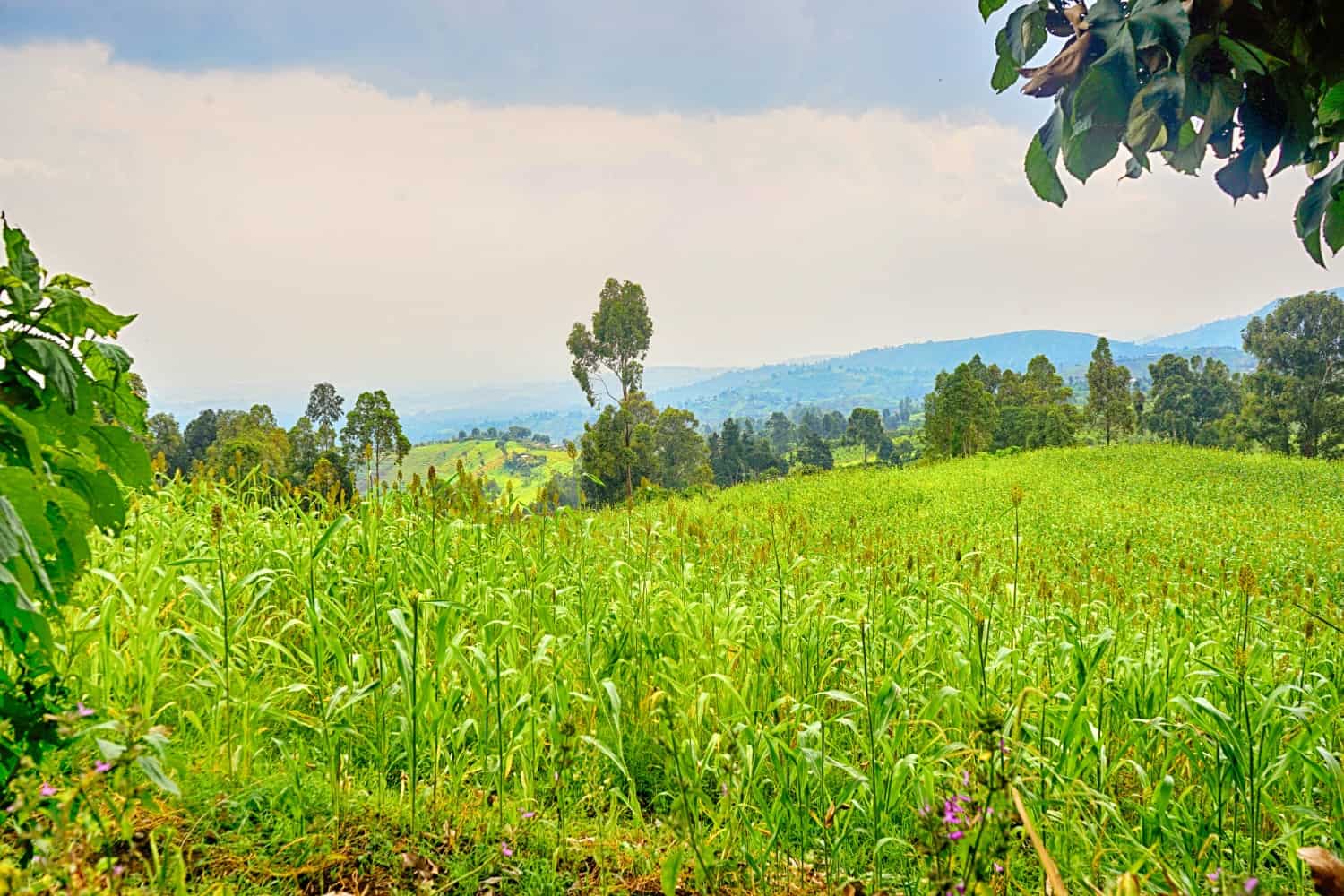
After two hours in the corn, our tracker received news of the family’s location, and we veered off-course and deep into the jungle.
We were truly in untouched territory here. There were no tracks to follow; no well-trodden path created by tourists. Instead, one of our guides took an enormous machete to the trees, hacking away at the vines and bushes to create a trail for us to follow.
Inside the jungle, it was cooler, but the walking was tougher. Over and over, I tripped over roots, stumbled across rocks, and got my shoes tangled up in the vines.
Suddenly, everyone was whispering and one of the guides was motioning for us to pull on our surgical masks.
Gorillas are able to catch human viruses and so you have to be incredibly cautious not to transmit any germs while you’re there. You can’t do the hike if you have a temperature, and you need to be wearing a mask when you’re around the animals. When you only have 800 mountain gorillas left on the planet, you don’t take any chances.
We crept into an open clearing and there they were.
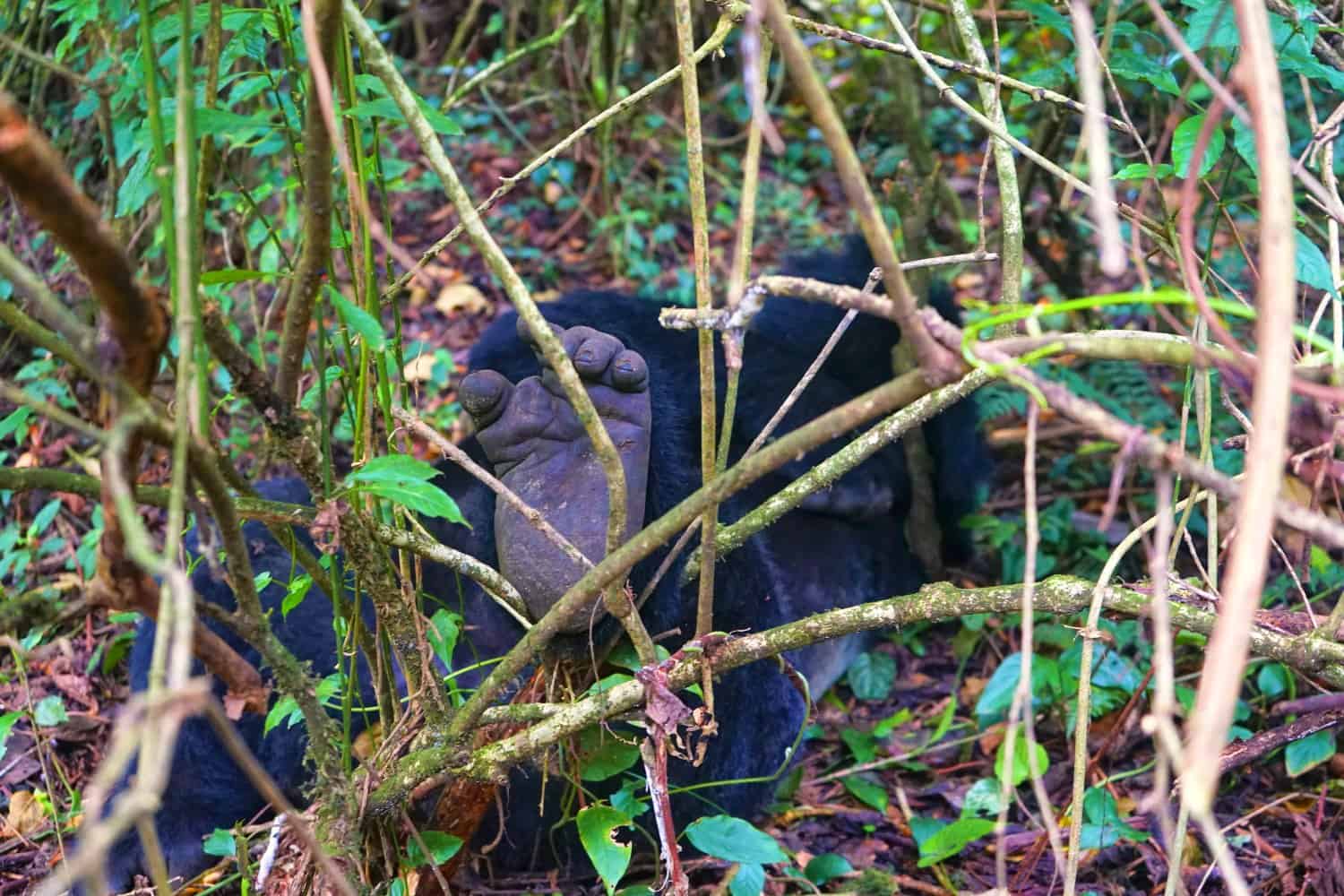
There were six mountain gorillas lazing on the forest floor metres from us — two silverbacks, a baby, and three children. One of them sneezed loudly. The baby began somersaulting across the jungle floor towards us.
We shuffled backwards in unison, breaths tightly held and blinking in disbelief.
These were wild animals. They were just behaving how they would be if we weren’t there. And they were so playful. Adults and children alike rolled around on the ground, hugging and pushing each other.
To the right of us, a female pummelled one of her babies in the face with her feet.
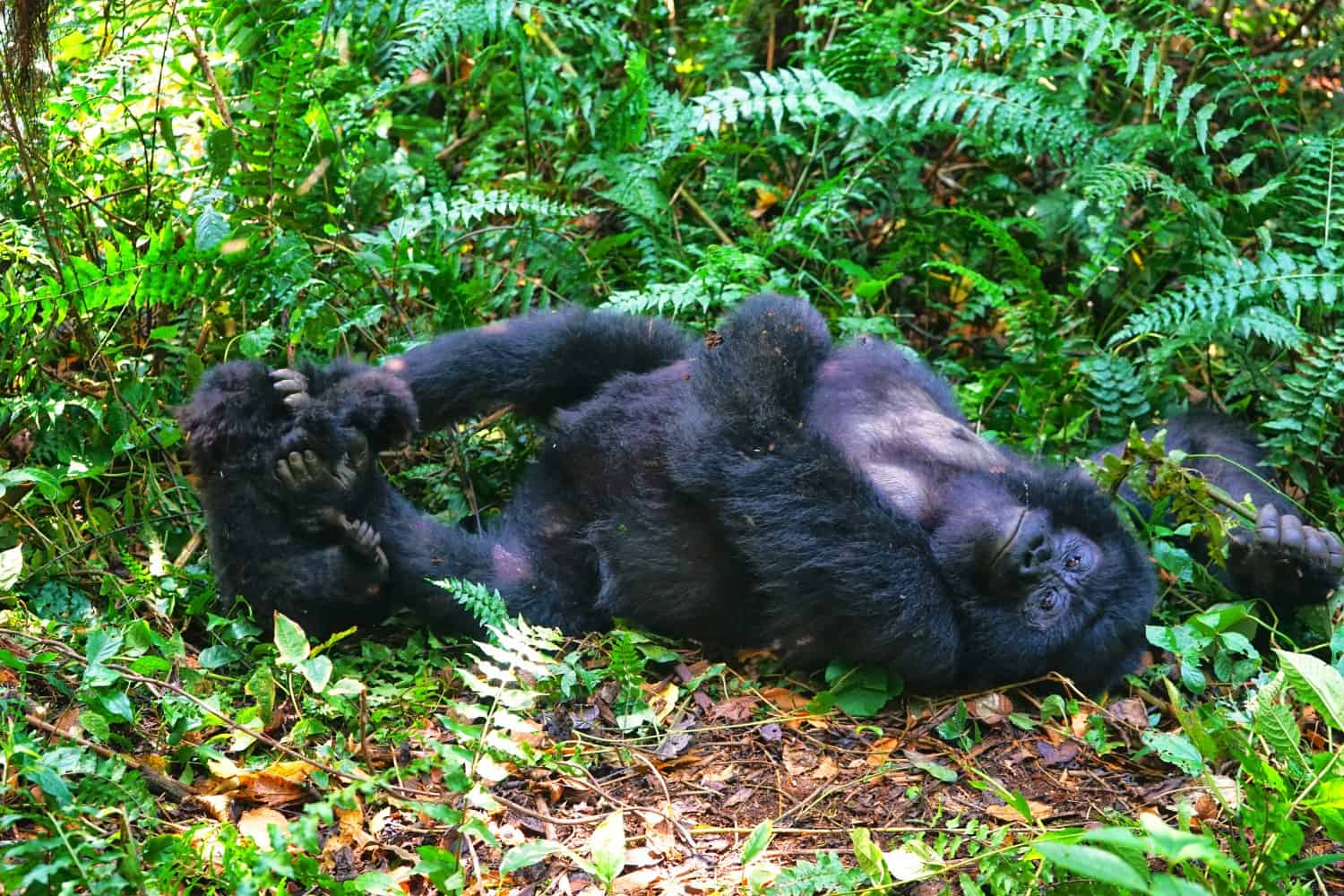
At our briefing that morning, we’d been told that the silverbacks in the family could charge at us at any time, and it would be for one of two reasons: either they wanted to play with us or they wanted to kill us. The guides would most likely know which one it was and try to keep the gorillas from attacking us.
We were told that in this situation, the best way to react was to slowly and calmly crouch down to the ground in front of the silverback, in order to minimise any threat they may have perceived from us. I’d kept this in mind throughout our trek to get here, but as soon as a giant gorilla started charging towards me, you can bet that I let out a whimper and dived into a nearby bush in terror.
Those guys are fast, huge, and made of muscle.
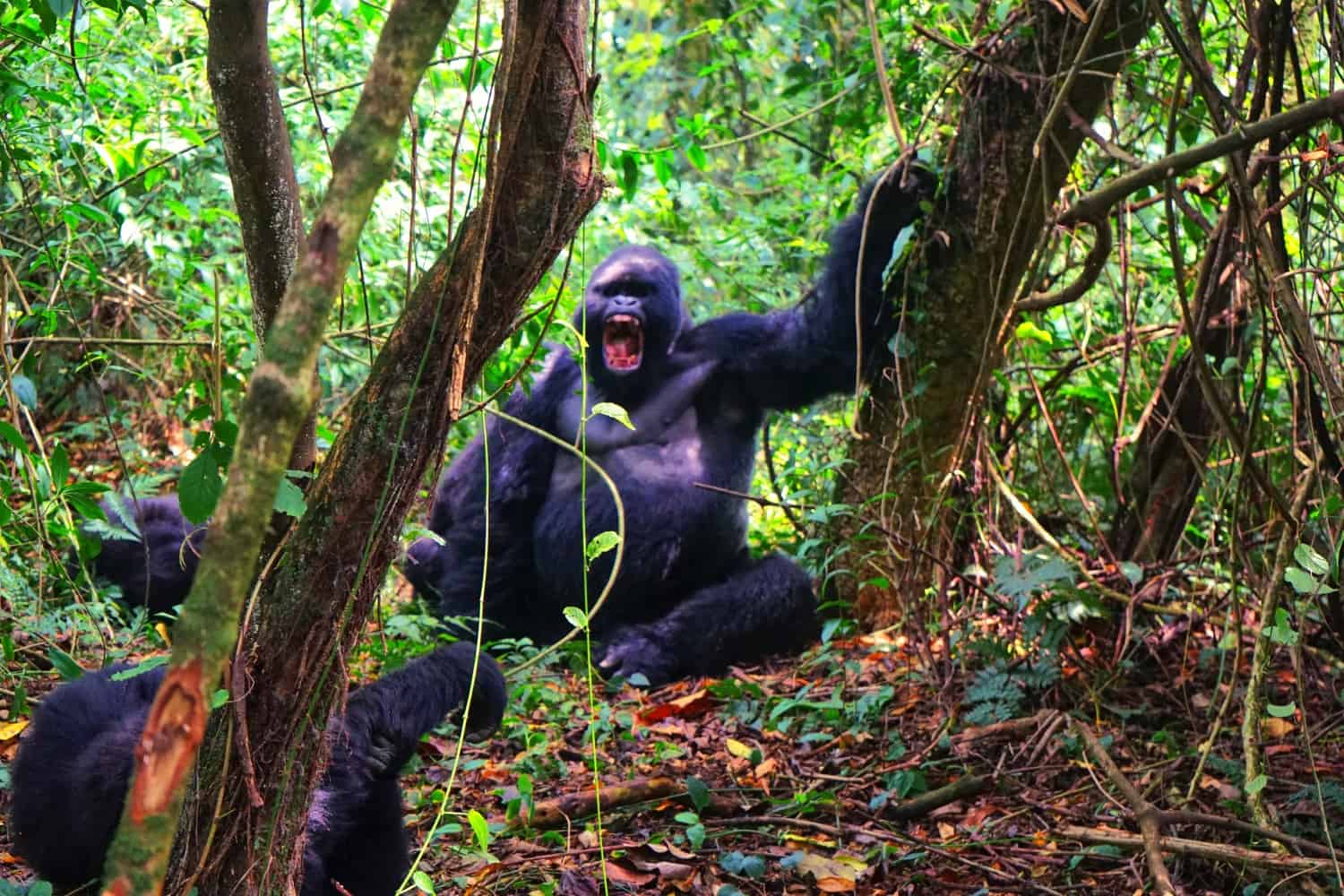
One of the guides motioned for us to make our way into a second clearing, where we found two gorilla children chasing each other around a tree trunk in excited circles. It was tough to hold in our squeals when they decided to continue their chase up a nearby tree for a few moments before they both came crashing to the ground.
Behind us, another enormous silverback let out a loud fart.
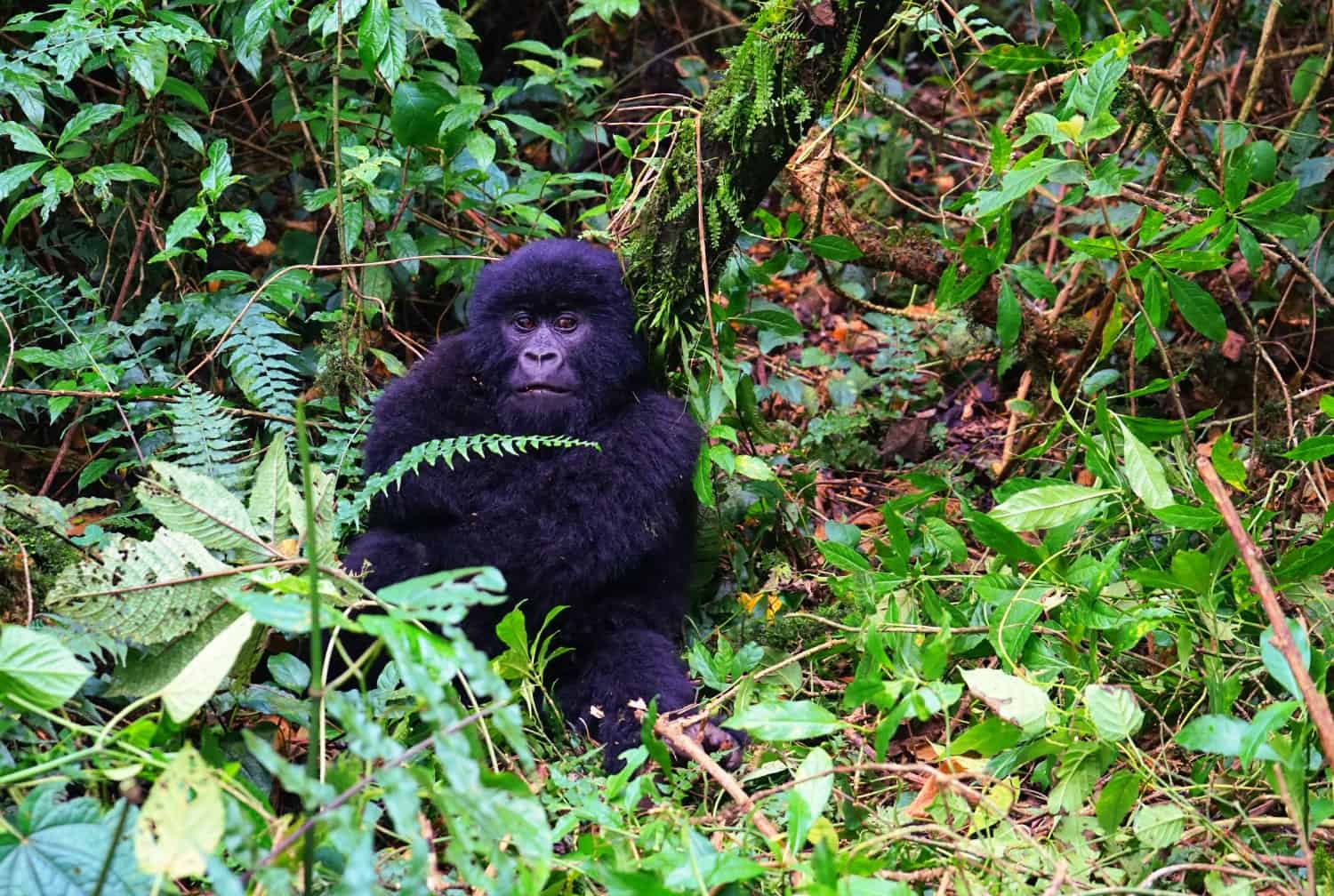
Suddenly, and without warning, the gorillas were on the move, lumbering through the forest and out of our eyesight. Our guides motioned for us to follow, hacking away at the foliage to create a walkable path for us.
We stumbled upon the family again in a different clearing, but now they were behaving like sulky teenagers, deliberating turning their backs to our cameras, unwilling to turn around to face us.
I couldn’t stop giggling over the scene. It was so humanlike!
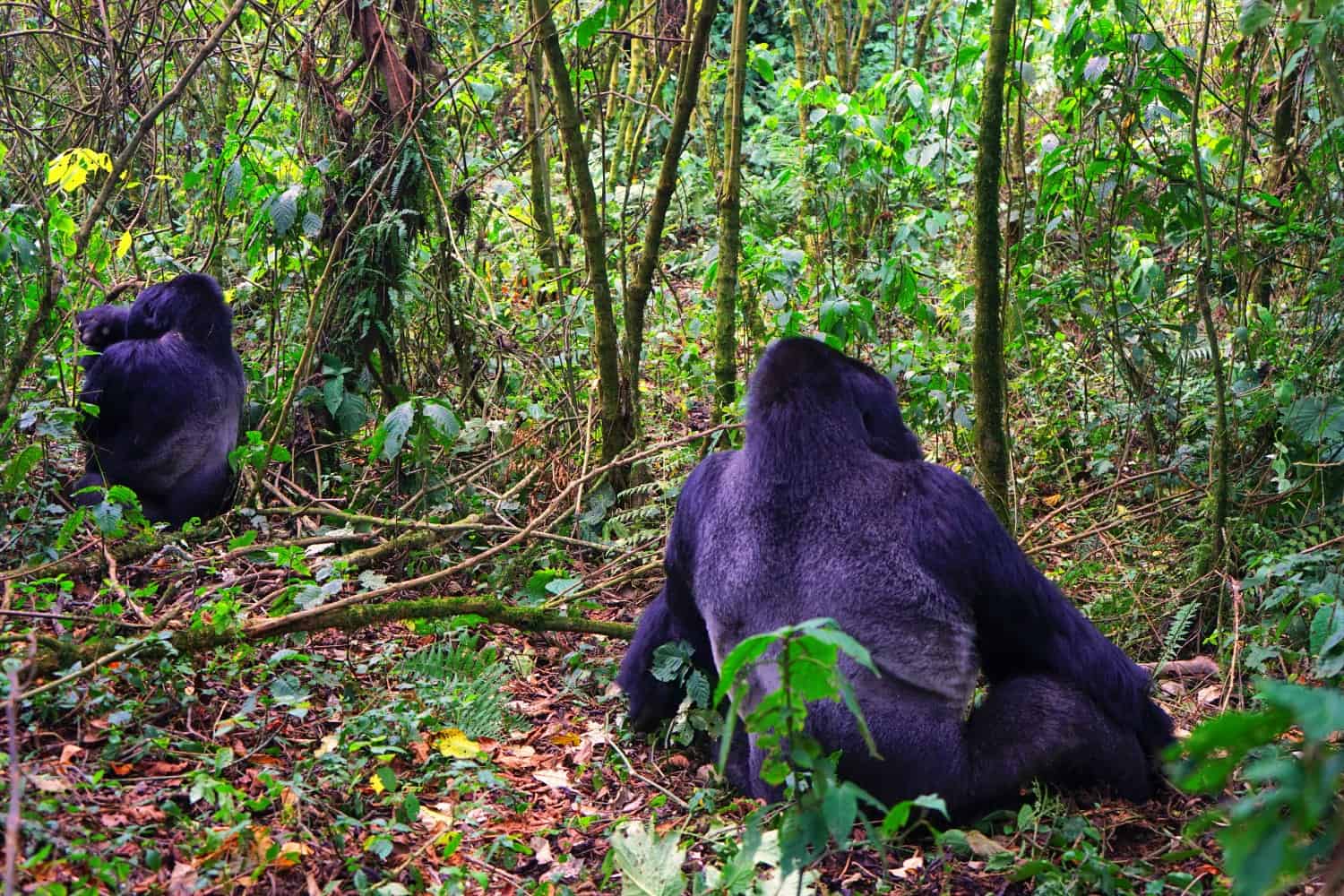
After several minutes spent taking photos of the gorillas’ backs, they were on the move once more, leading us to a tiny area where we were within metres of the two silverbacks.
And then, one of the most spectacular-yet-terrifying moments of my life: a giant silverback lumbered slowly towards us, getting closer and closer as we inched backwards into the bushes. Closer, closer, closer, and suddenly it was six inches away from where my hand was trembling. Had it reached out an arm to swipe at us, we could have been seriously injured. But it didn’t. It continued walking away into the jungle, leaving us hyperventilating in its wake.
We took that as our sign to leave. Our hour was up, and it was time for us to drag ourselves away from the gorillas.
This had been the single best animal encounter of my entire life.
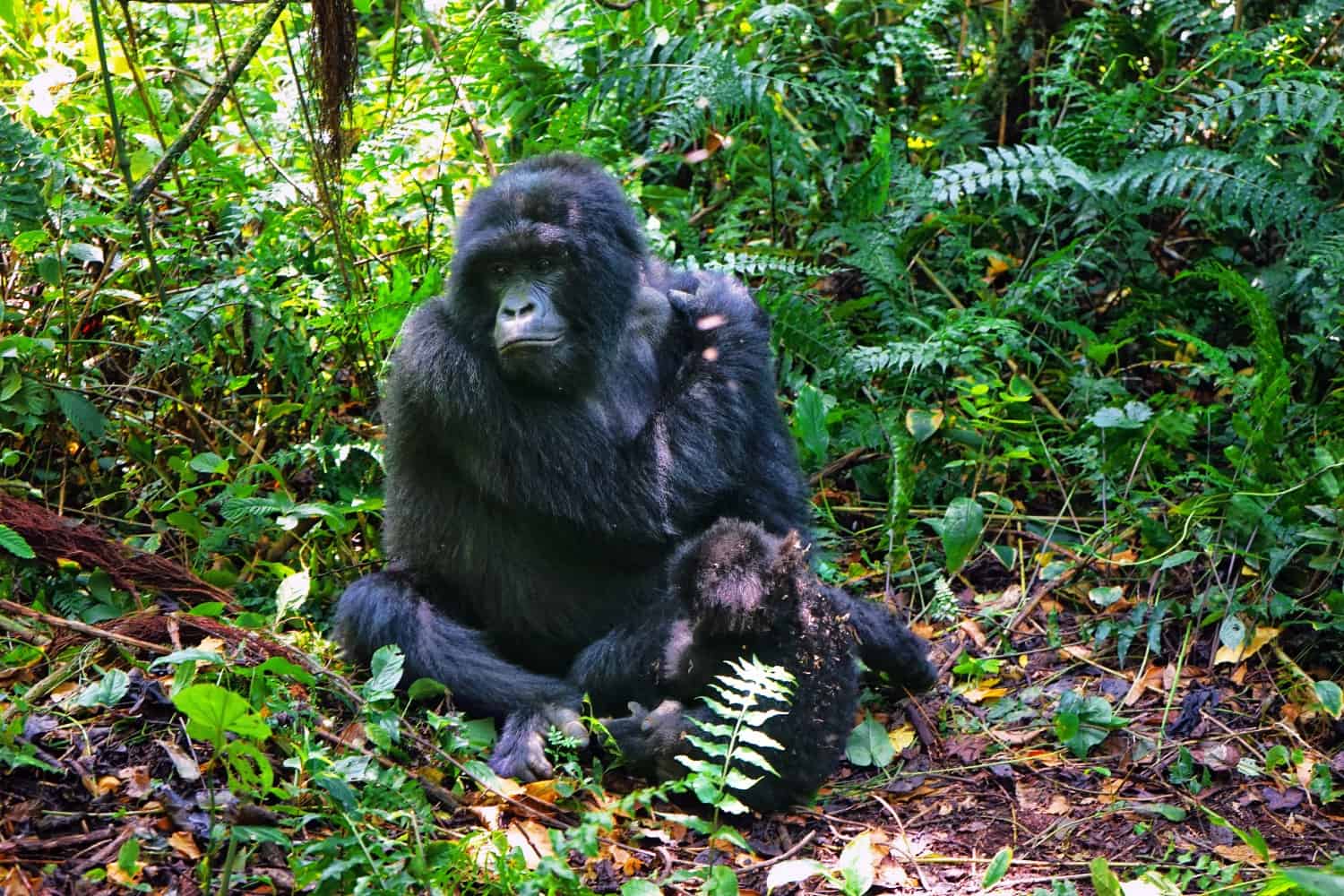
What to Know Before You Go
This is what I wish someone had told me before my trip:
- You need a reasonable amount of fitness to do the trek, but you don’t need to be super-athletic or anything. Bear in mind that the gorillas do move around a lot, so you could be walking for 30 minutes to see a family, or you could be heading out for a six hour round-trip. Virunga has a 100% success rate on these treks — they’ve never not seen gorillas, but that does mean you could be walking in the heat in search of them for quite some time.
- There’s no need to worry about luggage during the trek. You can leave all of your luggage at Bukima before you leave, and you’ll finish there afterwards and be able collect it. I left everything there, and took this small 20l daypack with me for carrying everything I’d need on the hike.
- Make sure you print out your confirmation receipt for Virunga before you go. You’ll be asked to show either it at every trek you do and all accommodation you stay at.
- Arrange travel insurance way in advance for your trip, and expect to struggle to find someone to cover you. SafetyWing is a good, affordable price travel insurance company that I personally use and recommend, and they do cover trips to the D.R.C. for most people. Battleface is another good option if you’re coming up with nothing, as they’ll insure pretty much anyone for any trip ever.
- You won’t be let into the country unless you have a yellow fever vaccine card that proves you’ve had the vaccine (or that you’re exempt if you’re over 65). Make sure you don’t lose this or you’ll be turned away at the border!
- As I mentioned earlier in the post, gorillas can contract human viruses and unfortunately, this does include COVID-19 and it can make them very unwell. There are a number of protocols in place to help prevent any transmission to wildlife.
- You’ll need to be vaccinated against COVID-19 to hike with the gorillas, and if you’re unvaccinated, you’ll need to take a PCR test within 72 hours of the trek to prove you aren’t currently infected. You’ll need to arrange to get this done in Rwanda, if that’s where you’ll be travelling from.
- All guests will need to take a rapid test on the morning of the gorilla trek.
- You’ll have your temperature taken at various points around the park as you travel around.
- You’ll be required to buy facemasks and hand sanitiser in advance and to bring them on your hike. I recommend N-95s in order to be extra cautious.
- Unvaccinated guests will also need to take a PCR test 72 hours before departure from the D.R.C in order to leave the country. You’ll need to get this done at Goma Hospital at a cost of $50, most likely once you have arrived in country.
- COVID requirements are always changing, so when you contact Virunga to book your package, you can always ask what the rules are at that time.
- I highly recommend picking up a local SIM card in Rwanda and adding credit for international phone calls. I went with MTN, and paid just under $15 for the SIM card, which gave me 7GB of data (you can sometimes connect to Rwandan towers in the DRC), and credit for five international phone calls. If anything goes awry on your trip, you’ll want to be able to contact someone at Virunga, so being able to make phone calls within the DRC could be important.
- An alternative to this is buying an eSIM for the DRC. You’ll pay for it while you’re at home and then cross the border into Goma and immediately have data. Plans start from $8 for 1 GB of data for a week. You’ll have to use Skype to contact Virunga using this option, as it’s a data-only SIM, but if you don’t mind that, this is the best way to ensure you’ll be able to connect to the internet while you’re in the country.
- Please do consider hiking Mount Nyiragongo after you’ve trekked to see the gorillas. It was such an incredible experience for me, climbing up an active volcano and then spending the night sleeping on the rim of its crater, listening to the bubbling of the world’s largest lava lake. It’s hard to put into words how life-changing it was! I wrote an in-depth guide to hiking Mount Nyiragongo, so make sure you check that out, too, if you’re on the fence about doing it.
How to Get to Virunga National Park/The Democratic Republic of the Congo
If you’re sensible, you’ll arrange to get your visa for the DRC through Virunga National Park. You can do it all online once you’ve bought your permit, and it was a seamless process from start to finish. My visa was approved within 48 hours and required no paperwork.
With this visa, however, you can only enter the country through the Grand Barrière border crossing between Gisenyi in Rwanda and Goma in the DRC. There are two border crossings in Gisenyi, so make sure you’re at the right one before you leave the country.
You’ll most likely fly into Kigali and then travel to Gisenyi via private car or public transport. The former is usually $100 each way, and the bus is around $15 to Gisenyi, then you’ll need a mototaxi for less than a dollar. It takes four hours to get from Kigali to Gisenyi — the roads are winding, so driving is slow going. This is the easiest and cheapest way to get to the park. Make sure you tell your drivers that you’re going to Grand Barrière.
The border crossing was incredibly easy, and no different to any other overland crossing I’ve done. Get stamped out of Rwanda, show your yellow fever card, get your temperature checked, and then get stamped into the DRC. The entire process took five minutes. If you encounter any problems when crossing the border (or anywhere else in the park), you can call Vianney on +243 99 1715401 for assistance.
How to See the Mountain Gorillas on a Budget
Even though the DRC is the cheapest country in the world to see mountain gorillas in the wild, it’s not a budget destination by any definition of the word. Permits are $400 (they’re $700 in Uganda and a whopping $1500 in Rwanda) and for that price, you’ll be allowed to spend one hour with the gorillas.
On top of that, you’ll need to take into account your visa for the DRC, which Virunga National Park takes care of and is priced at $105. On top of that you’ll potentially need to pay for accommodation in the DRC on either side of your trek if you’re not booking a package through Virunga. It costs $75 to stay at the excellent Lac Kivu Lodge before the trek, for example, but $316 to stay at Virunga’s Mikeno Lodge the night afterwards.
There are several things you can do to minimise your costs.
Rather than staying in the best guesthouse in Goma, you could opt to spend the previous night in a more inexpensive guesthouse in the city. Hotel La Versailles Goma is $50 a night for a double room, although receives terrible reviews. If all you want to do in the DRC is trek with the gorillas, you don’t need to spend the night in the DRC after your hike — instead you can arrange for the park to pick you up afterwards and take you straight back to the Rwanda border, where accommodation is inexpensive (in Gisenyi, rooms start from $11 a night).
Additionally, Virunga National Park drops the price of gorilla trek permits if you’re willing to go in the wet season. This year, between 15th March and the 15th May, the permits were half-price: just $200 each. If you’re on a tight budget and happy to risk potentially trekking in the rain (which totally happens in the dry season, too), this is absolutely the option for you.
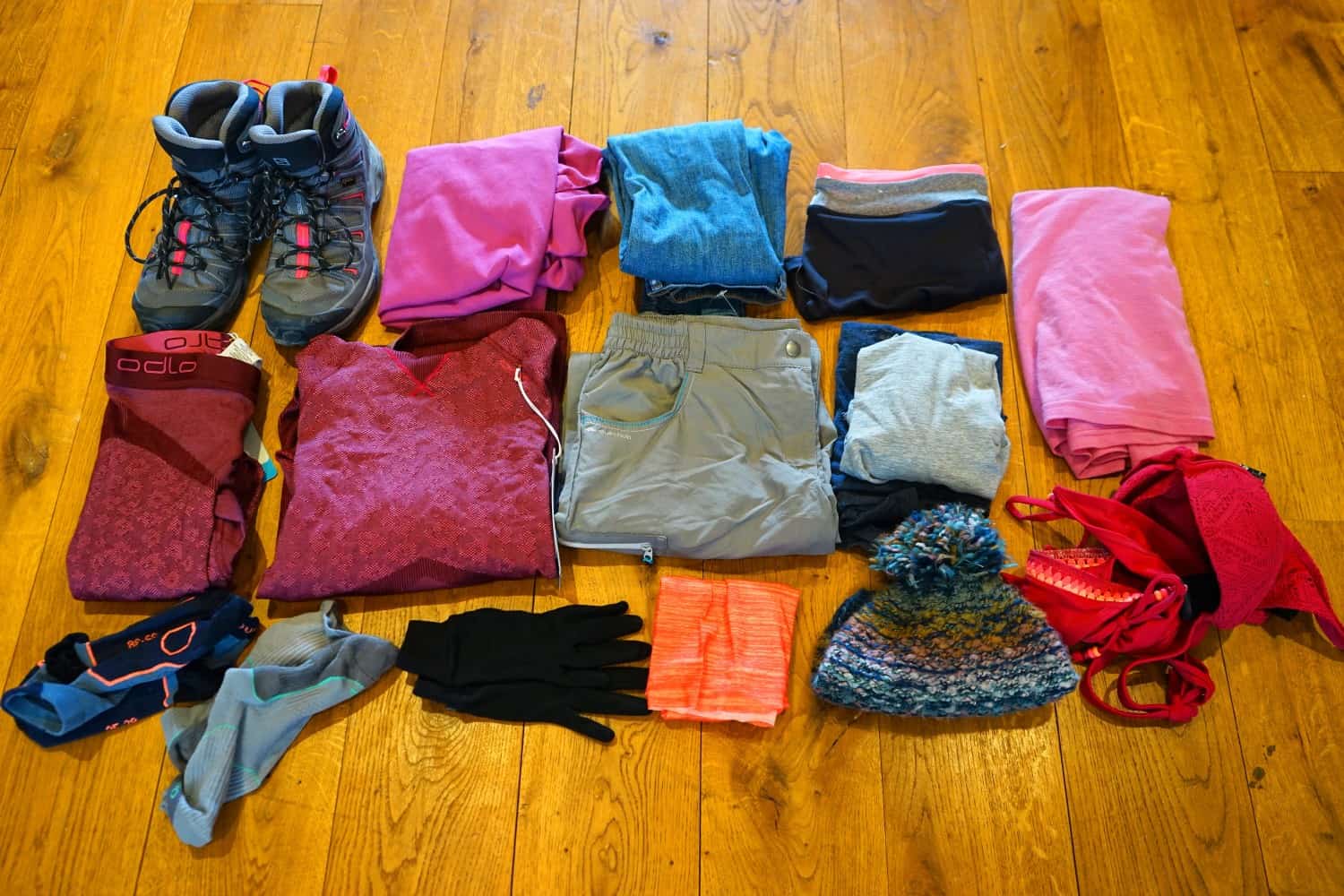
What to Bring With You on Your Trek
Weather is unpredictable in Virunga National Park, no matter what time of year you visit. You’ll want to make sure you have adequate waterproof gear for your trek because of this. A decent rain jacket that’s made of breathable material is one of the most important items to pack.
My favourite daypack at the moment is the Osprey Tempest 20l pack, which is perfect for hikes like this. It’s small and lightweight, but still has hip straps to keep the weight away from your shoulders. I could fit snacks, a water bottle, my camera, and warm/wet weather clothes inside.
Also important for the hike is long hiking pants. You’re walking through untamed jungle and fields for much of the walk, and the plants are seriously stabby. I even felt them through my pants at time! Definitely don’t wear shorts, and a breathable material is best, as mine got pretty hot and sweaty in the humidity.
Make sure you bring long socks, too, because you’ll want to tuck your pants inside them to protect from ants. This was something all of our guides warned us about, although we were fortunate not to have any ant issues in our group.
When it comes to clothing, dark colours are important. You don’t want to wear anything bright to attract the gorillas’ attention. Additionally, sunglasses are a no-no on this trek, as the gorillas might spot their reflection in them and try to swipe at it.
Sunscreen is an essential, as on our trek we were out in the sun for four hours and I would have definitely burned had I not applied it. For water, my GRAYL water bottle was invaluable in Virunga. This water bottle removes all the bad stuff from tap water — fill it with water, push the plunger into the bottle, and then you can start drinking. I’ve drank the tap water throughout Mozambique, Tanzania, India, and the Democratic Republic of the Congo with my GRAYL and never once got sick. As an additional bonus, you won’t be polluting the environment with plastic bottles when you use a GRAYL, and it’ll help you save money, too.
You’ll obviously want a great camera to capture the experience, although don’t be surprised if you come away with far fewer photos than you’d expected. I was so spellbound by the experience that I deliberately avoided spending all of my time viewing the gorillas from behind the lens. I travel with the Sony A7ii plus 28-70 mm lens, and highly recommend it for travelers. There’s no need to bring a zoom lens on this trek, as you’ll always be within several metres of the gorillas.
Finally, hiking boots are a good option for gorilla trekking in the DRC. Choose some that are comfortable, water-resistant, if not waterproof, and that have been well worn in beforehand.
Is gorilla trekking in the DRC on your bucket list?
Related Articles on the D.R.C:
🇨🇩 Climbing Mount Nyiragongo: A Hike to the World’s Largest Lava Lake
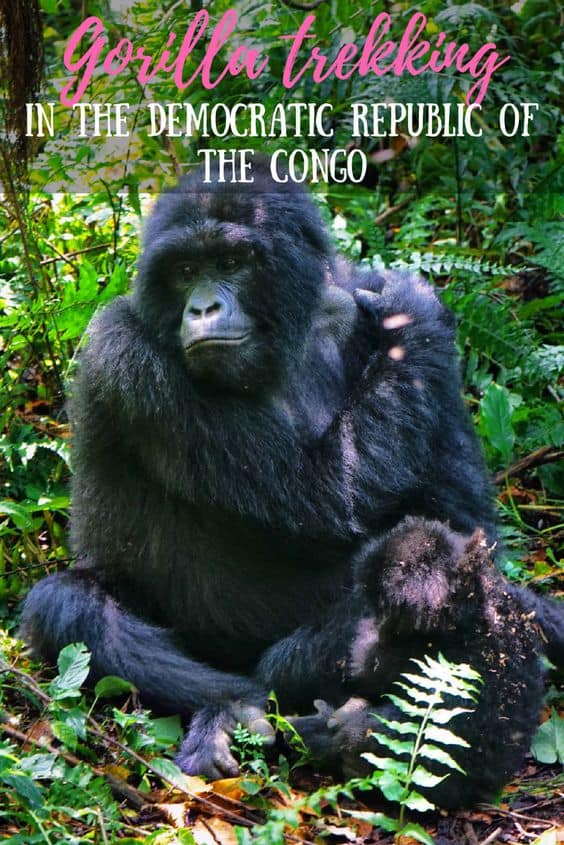



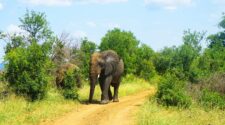
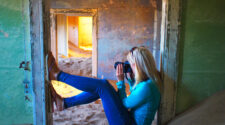
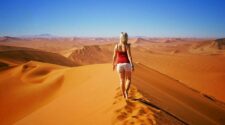
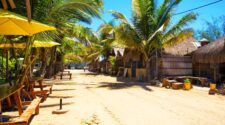
That looks like a very interesting time. Expensive, as you say, but you write as though it was well worth it. The playfulness you mention is neat. I don’t do bucket lists (except to sneak up part of the Matterhorn for a foto of the main face, then leg it).
It was so worth it, Ted! I’m even thinking of returning next year to do it all over again because it was such an amazing experience.
What an absolutely incredible experience! I can’t even imagine how amazing it must have been!! Also, I have so much respect for those rangers and everything they do to protect the wildlife.
Right? They’re so inspirational.
There is so much I love about the post! First, I never knew anything about Virunga National Park. The rangers are definitely kick ass and I can certainly appreciate the women rangers.
Actually, I never knew you could do a gorilla trek nor what it would entail, so I’ve learned a lot! It sounds like a unique and amazing experience.
I also like how you’ve broached the topic of traveling somewhere considered unsafe. I feel that you were thoughtful and not reckless.
Do you have any pictures of the black volcanic rocks?
I only have blurry photos of the rocks, but this Google Image search: https://www.google.pt/search?biw=1244&bih=676&tbm=isch&sa=1&q=goma+lava+rocks&oq=goma+lava+rocks&gs_l=psy-ab.3 shows just how unusual the city looks!
That sounds absolutely incredible. Thanks for your helpful advice, and for raising awareness of the amazing work being done by the rangers. This is definitely going on the bucket list!
I hope you make it there, Melanie!
I didn’t even know the option existed to see gorrillas in the DRC. Really interesting article and useful information. I’d love to go…
I actually didn’t either until I began researching gorilla trekking in Rwanda and started looking at alternatives.
Fantastic post. I’ve been reading a few blog posts recently about gorilla trekking and it’s now firmly on my bucket list.
I just finished reading How Not to Travel the World, so the paragraph in this post that you started with “Always up for trying a new dish..” made me laugh a little bit. I love seeing how much travel has helped change you and I can really relate to that!
Ha, yes! I think my eating habits have been the biggest transformation for me — now I’ll eat anything and everything without a moment’s hesitation! :-)
Oh wow, what an amazing experience!! Great post, it’s made me want to do this even more now :-) I wasn’t aware you could do gorilla trekking there, it’s definitely an interesting alternative.
I highly recommend checking it out! :-)
Ahhh this is so amazing! I’m so glad for you that you have this experience to remember forever. It looks incredible :)
Thank youuuu! :-) It was easily one of the best things I’ver ever done!
What an awesome experience! I have trekking to find gorillas really high on my wishlist, however, I’m scared that my fitness isn’t good enough. I’m not sure I would survive a 6 hour hike if it would come to that! Maybe next year :-)
You could also luck out and have a 30-minute trek to see them! You don’t need to be super-fit, though, just do a few 10-mile walks before you go and you should be fine.
Isn’t it amazing?
I went Gorilla Trekking back in 2004, in Rwanda. Love your reason for choosing DRC over Rwanda/Uganda and so nice to read positive things about a country that people are made to feel scared of. Obviously like you say there are very real dangers but there are ways to visit safely :-)
Your photos are brilliant! Especially the open-mouthed gorilla shot!
Thanks so much, Amanda! And yes — it was easily one of the best things I’ve ever done :-)
I am speechless! This Looks insane! I’d love to do this one day
I hope you get to! :-)
This is one of the coolest experiences I have ever read about! I think I might be slightly terrified being that close to the gorillas, but… worth it.
So worth it! They’re definitely a little intimidating, and the silverbacks are ENORMOUS. But I never felt like I was in any serious danger while I was there.
Amazing, amazing, amazing. I landed here after researching gorillas trekking in Rwanda and realising it’s simply too expensive for me to be able to afford. Thinking about the DRC as an alternative. What do you think about Uganda in contrast to the Congo? Much safer, I assume. But it does sound as if Virunga National Park is actually very safe. I don’t want to put myself in danger as a solo woman but I also don’t have much money to spend either. WHy does it have to be so expensive!?
Well Done Lauren! You are so wonderful to visit the D.R Congo to see the Gorillas. Whenever I get the chance to go from Cario to Cape Town. I’ll make sure I’ll stop in the D.R. Congo for the Gorillas.
Just wondering, you didn’t need a double entry visa for Rwanda?
Nope! I can get a visa on arrival, so I just got one when I landed, and then another one when I crossed back from the DRC. I hope you make it there while you’re on your kickass-sounding trip! :-)
She looks badass even from the back! And wow!! Those gorillas look huge. Not sure if I find them cute or scary yet… Thanks for the tips too!
Right? I hate taking pictures of locals when I travel, so I always end up with sneaky shots from behind lol.
Hi Lauren,
This sounds incredible – and you’re right, the Virunga website looks great. Just trying to establish a feasible itinerary for a similar trip.
I was imagining flying into Rwanda, spending a couple days in Kigali, taking a taxi to Goma, staying one night, doing the gorilla trek, stay in Goma again for another night or two, then going to do the volcano trek, returning to Goma for another night, and then back to Rwanda.
Probably all the Goma nights at one hotel. Is this the best way?
Do you book all the transport through the Virunga website (there and back on the same day for the gorillas, and there one day, back the next for the volcano?)
Thanks, sorry I am so nitty gritty – looks incredible.
Hey Adrianne! :-) That sounds good to me. If you were staying in the same Goma hotel, you could leave your luggage there, which would make the trip less of a hassle. I booked all of the transportation through Virunga, yep! You could organise your own transport in Goma with a random dude on the street to save money, but I liked having the protection of rangers in the truck with me.
Wow!
I really like your write-up Lauren, which was very detailed and to the point!
Is gorilla trekking in the DRC on my bucket list? Ha! Ha! Absolutely not!
I have a terrible fear of anything from the primate world brought on by a monkey who climbed on my head, and started pulling my (then) long hair in Bali!
In fact, I can’t even watch “Planet of the Apes” without getting into a nervous sweat. I’ve been dying to watch the latest film but I simply can’t go on my own. I’m too scared!
Hahahah! Definitely not an option for you, then! :-D I totally agree with you about the monkeys in Bali, though — they’re a nightmare to deal with!
Just incredible.. So human like! It must have been amazing to see them in the wild, that close up.
It was breathtaking! I had to keep reminding myself that they were in the wild, because I’ve had so few encounters like this anywhere in the world :-)
This has been on my dream list for as long as I can remember – always assumed I’d have to do it in Rwanda. Thanks for showing me that there’s an affordable alternative. Sounds lifechanging!
Rwanda has suddenly become so ridiculously expensive that I wouldn’t be surprised if they dropped the prices of permits in the future.
This is such an incredible story! I would love to do a gorilla trek. I know I’d be a bit terrified, but the danger would also be part of the charm. The picture of the female ranger with the gun is so badass. I thoroughly enjoyed reading your account of such an incredible adventure! Bookmarking for future reference! Thanks so much! <3
It was a bit nerve-wracking, but I don’t think many people have been harmed while doing it, which definitely set my mind at ease. And anyway, it’s totally worth the very small risk! :-)
This is unreal!! Definitely a bucket list item that I won’t be able to afford for a very long time, but it would be so worth it! I’d never think of going to the DRC either. I’m really glad you write about places like this!
I’m so glad you enjoyed the post, Clazz! :-) It’s so, so worth the expensive price tag, so I hope you make it there in your lifetime.
Wow, wow, wow! Are the gorillas in any danger of become extinct any time soon? Should we be looking at visiting within the next few years to ensure we actually see them while they’re on this planet? Sounds like an amazing experience and I loved all of your photos.
Congo is offering a promotional discounts on gorilla tracking at a half price starting 15th October to 15th December 2017, during this given time above gorilla tracking permit is sold at only 200USD, for the budget travelers this is the time for you.
Thanks for sharing, Olivia!
This. Looks. AMAZING! Wow. Had never considered the Congo as a tourist destination before but I have to say you’re really selling it. Especially to budget travelers who can’t spend much money on such an experience.
Thanks Mysheel! I highly, highly recommend checking it out — it’s easily one of the best things I’ve ever done, and offers a much cheaper way of seeing the gorillas than anywhere else in the world!
Thank you for this helpful post Lauren! Easily the best I’ve seen about gorillas in the DRC. It’s this post that convinced me to splash the cash and take the risk and head over the border. Hope I have as amazing an experience as you did!
I hope so, too! I’m sure you will, though, as any experience with wild mountain gorillas is a good one ;-)
I loved the experience of visiting with wild serverbacks in the jungles of Rwanda when I visited. Silverback Gorilla trekking in Rwanda was easily one of my top travel experiences ever. Great write up and photos here! Keep it up!
It’s an incredible experience, isn’t it? :-)
This is a great post. You are taking a huge risk here, but I think it’s worth it. The hotel was beautiful and these Gorillas looks awesome. And It’s sad to hear safe keeping these giants is a life threatening job. Keep travel mate, be safe. Cheers.
Glad you enjoyed the read! :-) It was 100% worth the (very small) risk!
Hi Lauren, I really enjoyed reading this, thanks for sharing your story and tips. I am going to Goma for work in Apr/May and want to take the opportunity to go and see gorillas too. Do you know if it is as likely to see gorillas during the rainy season!
Yes, definitely! Our guide said they’ve never *not* seen the gorillas in all of the years they’ve been running treks, so you’re pretty much guaranteed to see them :-) Hope you have an incredible time while you’re there!
Hi Jessica, April / May is low season which comes with a big discount on Congo gorilla permits going for only $200. The rainy season is always a good time to see gorillas as the forest is green the gorillas dont have to move further into the forest in search for food, hence you wont have to hike deep into the forest in search for gorillas.
Thanks for sharing!
Thanks for the article Lauren. Gorilla trekking is the ultimate wildlife experience one can have in their lifetime. A safari to spot the big 5 is great but the experience of tracking gorillas is something.
I am glad that you chose to do it in Congo. Most visitors choose Congo because of the cheaper cost – I mean think about a 1500USD gorilla permit to trek in Rwanda. But choosing Congo shouldn’t be so just because of the lower permit fees.
I have done trekking in Uganda too and my best experience was definitely in Congo. Virunga national park has this raw beauty that is hard to find elsewhere. When you visit Congo, you get this true reflection of Africa as it once was – away from the modernization.
Unfortunately bad press has kept of many potential visitors from visiting Congo. The wardens in Congo take the security of visitors very serious. Yes! There are guns everywhere but I advice visitors to ignore some of the exaggerated security information they read over the net and read articles like this.
Eventually peace will prevail in the country and I see DR Congo becoming a number one destination. There is so much potential for the tourism industry there – way beyond gorilla trekking. I could go on and on about the other unique species there, but…
Every tourist I have encountered in my tour operator work has their special way to describe the Virunga National Park and their experience after visiting this park comparing to other african parks. Virunga has a hidden mystery in it and yes when when the political situation will be calm, the DR Congo will become the number one safari destination in Africa. Hopefully, very soon the Virunga National Park will re-open, let’s just see how the elections results unfold.
I really hope that will be the case. Virunga has so much to offer visitors.
Hi Lauren,
I bet you had a great experience there! Chukudu, the name is strange as it looks. Never know something like this exists! I do salute the ranger for their heroic contribution.
I like the way you put all the resource, guideline and website link in this article. Will definitely go there someday.
Cheers!
Thanks so much, Danny! I hope you make it there!
Gorilla trekking is the most amazing experience I’ve ever had. I did it in Rwanda before it got prohibitively expensive. I really wanted to go to DRC on that trip, but it was 2010, so definitely not an option back then :-(
But oh those ants – you’re so lucky you didn’t come across them! They’re huge and a bite hurts like hell.
Oh wow! Definitely glad I didn’t come up against any then :-)
i was looking for the price of gorilla tracking in congo and i landed on this site. well done keep up the good work.
Thanks!
I am so inspired by your post! It looks amazing and I am looking to go to the DRC for a gorilla trek this summer. Just curious, if I am going to go back to Rwanda after the trek, do I need to get a separate visa or will I be able to cross back again? I am having a hard time finding the answer to that. Thanks!
I want to do this!!
Who did you book through ? Could you please send the link through :)
Thanks!
Just through Virunga National Park’s website. https://visitvirunga.org/
Hi Lauren,
I’m glad that you had such a great experience. One of the reasons that you decided to go there was because the gorilla permits were cheaper. You have mentioned several times that you felt safe, even stating that no foreigners have been killed. Last week two British people were kidnapped and a guide was murdered protecting them. Last year 11 guides were murdered. In such a dynamic political situation it may be prudent not to advise people to travel here based on your one single experience.
Yeah, I’ve been keeping updated on the political situation in the DRC, as well as the horrifying kidnaps. Humans are terrible at judging risks, though, and I try to take emotions out of my decisions and base them on statistics. It’s still the case that no tourists have ever been killed in the park, and having two tourists kidnapped in 20 years does not mean there’s an enormous risk for visitors. Over 100 people die in national parks in the U.S. every year, and I don’t feel as though I need to warm people against visiting those. I’m keeping an eye on the situation, though, and if anything further happens, I’ll update the post. It could be a one-off, and we’ll go another 20 years without anything happening to the tourists that visit.
By the way, I didn’t go because they were cheaper. I went because I wanted to support the park. I was just making note of the cheaper rate for my readers.
Hi Lauren!
Please, tell us which is the best place or airport to arrive in order to minimize money spending?
I did in the blog post. Fly into Kigali, take a bus to Gisenyi, and walk across the border to Goma.
The nearest airport is Kigali International Airport. However with Ethiopian Airways you can land directly in Goma.
I think, though, that if you’re arranging your visa with Virunga, you have to cross overland, so Goma airport wouldn’t be useful.
You are the perfect example of someone who has the most memorable trips by edging into fears Lauren. DRC can be tough but this is a gem of a nation from what I have seen, because the gorilla experience and raw nature and pristine beauty is unreal in those parts. Fabulous.
Hello Lauren.
Great photography and what an amazing experience. Any recommended hiking spot in Asia for first-time hikers? Hiking in the jungle always the risk. Some go to explore the vast desert; some go for an adventure in deep forests, and others love to climb high mountains, cliffs, and caverns. In the deep forest, there is a snack fear. To protect this situation snack boot is perfect for jungle hiking.
What about Borneo? Lots of great hiking there!
Lauren, what a beautifully written and highly informative piece. THANK YOU! Now i will just have to wait for the baby to be a little older and convince my parents to watch the 3 kids so my husband and I can do this exact trip that you did. Thanks so much!
Ha! I hope you manage to convince them :-) It was one of the most incredible trips of my life!
Hi Lauren,
thank you for this great article. The park reopened for tourisme last month and I am thinking to go there.
As you seem to know a lot about the country I was wondering what is your feeling about security in Goma those days…? Sleeping in this town is so cheaper than the lodge in the park… but do you think it is safe? My first thought was to spend the money to go to the lodge but… if I can spare some with a night or two in Goma it would be nice. It is not that I fear, it is just that I have absolutely no idea about what is going on there…
Thank you you if you find the time to answer.
Margot
Wow! With your very descriptive writing, it was almost like I was there with you! Thanks for sharing your amazing adventures with us. I love reading about all of them.
Ah, what a compliment! Thank you so much, Shelly :-)
Wow! very well detailed. I enjoyed reading each line. Am planning to visit Congo sometime this year and this was so helpful. For now i understand the permit is USD 450.
Yep! I hope you have a great trip!
What an explanation of your experience!
I could imagine each and every experience while reading it.
Just amazing!
Thank you! I’m happy you enjoyed the read, Sandeep! :-)
I was looking for detailed information about gorilla trekking in DR Congo and i landed on your article
Thanks very much Lauren